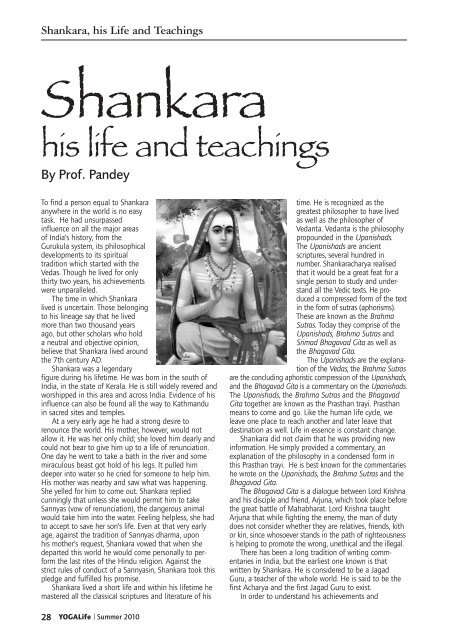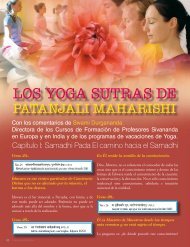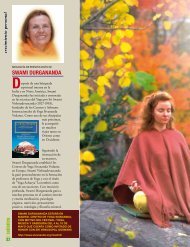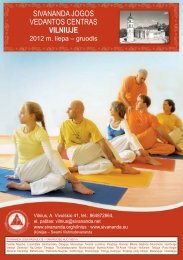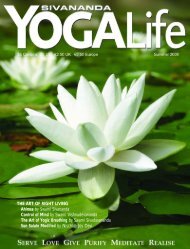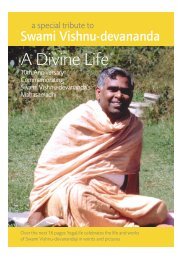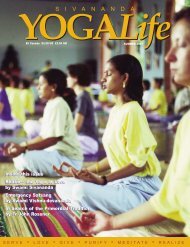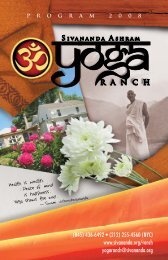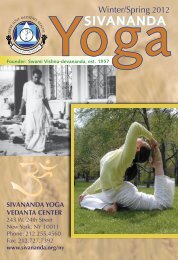YOGALife I Summer 2010 - Sivananda Yoga
YOGALife I Summer 2010 - Sivananda Yoga
YOGALife I Summer 2010 - Sivananda Yoga
You also want an ePaper? Increase the reach of your titles
YUMPU automatically turns print PDFs into web optimized ePapers that Google loves.
Shankara, his Life and Teachings<br />
Shankara<br />
his life and teachings<br />
By Prof. Pandey<br />
To find a person equal to Shankara<br />
anywhere in the world is no easy<br />
task. He had unsurpassed<br />
influence on all the major areas<br />
of India’s history, from the<br />
Gurukula system, its philosophical<br />
developments to its spiritual<br />
tradition which started with the<br />
Vedas. Though he lived for only<br />
thirty two years, his achievements<br />
were unparalleled.<br />
The time in which Shankara<br />
lived is uncertain. Those belonging<br />
to his lineage say that he lived<br />
more than two thousand years<br />
ago, but other scholars who hold<br />
a neutral and objective opinion,<br />
believe that Shankara lived around<br />
the 7th century AD.<br />
Shankara was a legendary<br />
figure during his lifetime. He was born in the south of<br />
India, in the state of Kerala. He is still widely revered and<br />
worshipped in this area and across India. Evidence of his<br />
influence can also be found all the way to Kathmandu<br />
in sacred sites and temples.<br />
At a very early age he had a strong desire to<br />
renounce the world. His mother, however, would not<br />
allow it. He was her only child; she loved him dearly and<br />
could not bear to give him up to a life of renunciation.<br />
One day he went to take a bath in the river and some<br />
miraculous beast got hold of his legs. It pulled him<br />
deeper into water so he cried for someone to help him.<br />
His mother was nearby and saw what was happening.<br />
She yelled for him to come out. Shankara replied<br />
cunningly that unless she would permit him to take<br />
Sannyas (vow of renunciation), the dangerous animal<br />
would take him into the water. Feeling helpless, she had<br />
to accept to save her son’s life. Even at that very early<br />
age, against the tradition of Sannyas dharma, upon<br />
his mother’s request, Shankara vowed that when she<br />
departed this world he would come personally to per -<br />
form the last rites of the Hindu religion. Against the<br />
strict rules of conduct of a Sannyasin, Shankara took this<br />
pledge and fulfilled his promise.<br />
Shankara lived a short life and within his lifetime he<br />
mastered all the classical scriptures and literature of his<br />
28<br />
<strong>YOGALife</strong> I <strong>Summer</strong> <strong>2010</strong><br />
time. He is recognized as the<br />
greatest philosopher to have lived<br />
as well as the philosopher of<br />
Vedanta. Vedanta is the philosophy<br />
propounded in the Upanishads.<br />
The Upanishads are ancient<br />
scriptures, several hundred in<br />
number. Shankaracharya realised<br />
that it would be a great feat for a<br />
single person to study and under -<br />
stand all the Vedic texts. He pro -<br />
duced a compressed form of the text<br />
in the form of sutras (aphorisms).<br />
These are known as the Brahma<br />
Sutras. Today they comprise of the<br />
Upanishads, Brahma Sutras and<br />
Srimad Bhagavad Gita as well as<br />
the Bhagavad Gita.<br />
The Upanishads are the explana -<br />
tion of the Vedas, the Brahma Sutras<br />
are the concluding aphoristic compression of the Upanishads,<br />
and the Bhagavad Gita is a commentary on the Upanishads.<br />
The Upanishads, the Brahma Sutras and the Bhagavad<br />
Gita together are known as the Prasthan trayi. Prasthan<br />
means to come and go. Like the human life cycle, we<br />
leave one place to reach another and later leave that<br />
destination as well. Life in essence is constant change.<br />
Shankara did not claim that he was providing new<br />
information. He simply provided a commentary, an<br />
explanation of the philosophy in a condensed form in<br />
this Prasthan trayi. He is best known for the commentaries<br />
he wrote on the Upanishads, the Brahma Sutras and the<br />
Bhagavad Gita.<br />
The Bhagavad Gita is a dialogue between Lord Krishna<br />
and his disciple and friend, Arjuna, which took place before<br />
the great battle of Mahabharat. Lord Krishna taught<br />
Arjuna that while fighting the enemy, the man of duty<br />
does not consider whether they are relatives, friends, kith<br />
or kin, since whosoever stands in the path of righteousness<br />
is helping to promote the wrong, unethical and the illegal.<br />
There has been a long tradition of writing comm -<br />
entaries in India, but the earliest one known is that<br />
written by Shankara. He is considered to be a Jagad<br />
Guru, a teacher of the whole world. He is said to be the<br />
first Acharya and the first Jagad Guru to exist.<br />
In order to understand his achievements and


